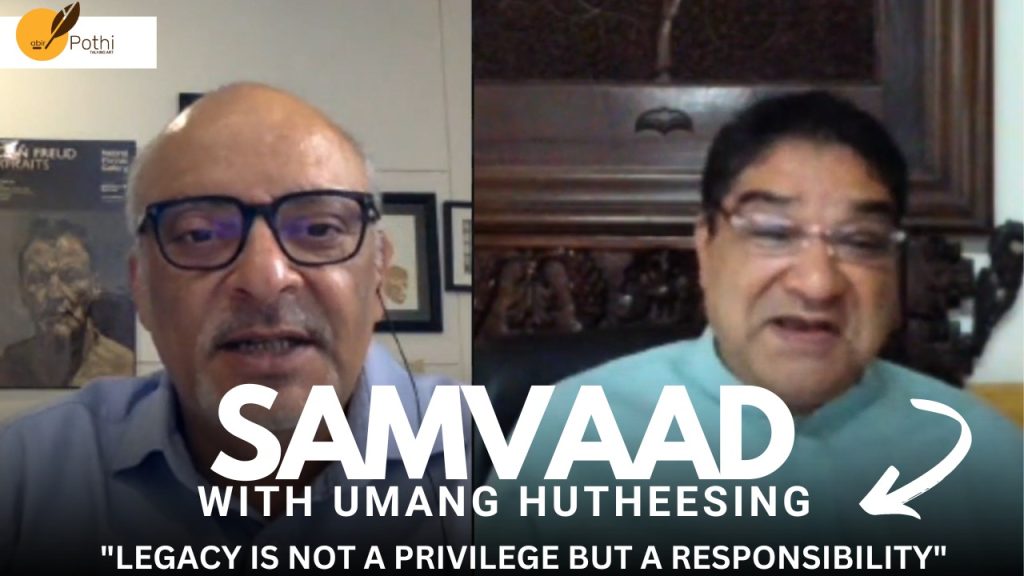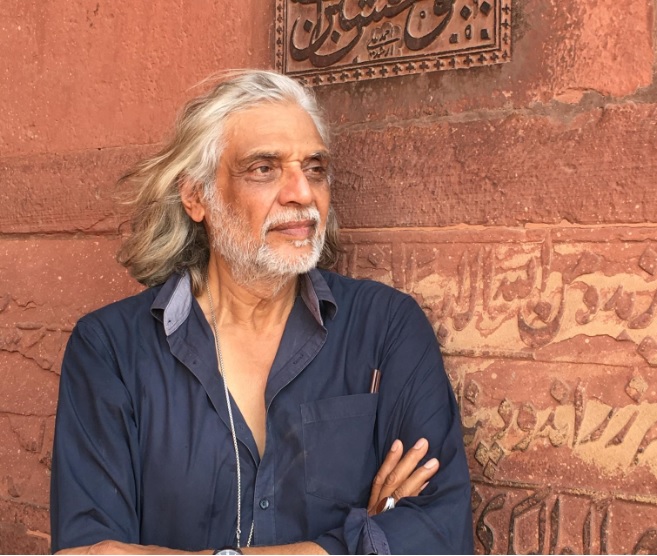Welcome to Samvaad, where art meets conversation, and inspiration knows no bounds. Here we engage in insightful conversations with eminent personalities from the art fraternity. Through Samvaad, Abir Pothi aims to create a platform for thought-provoking discussions, providing readers with an exclusive glimpse into the creative processes, inspirations, and experiences of these creative individuals. From curating groundbreaking exhibitions to pushing the boundaries of artistic expression, our interviews shed light on the diverse perspectives and contributions of these art luminaries. Samvaad is your ticket to connect with the visionaries who breathe life into the art world, offering unique insights and behind-the-scenes glimpses into their fascinating journeys.
This is part 1 of the Samvaad between Nidheesh Tyagi from Abir and Umang Hutheesing, the founder and president of the Hutheesing heritage foundation. Umang Hutheesing is on the governing board of the Ahmedabad Education Society, a managing trustee of the Hutheesing Visual Art Centre, and most importantly is the president and fifth generation of Hutheesing to manage the Hutheesing Design Company and Studio from the very same historic location, Jaising bhai-ni-wadi. He is also the founder and president of the Hutheesing heritage foundation which has restored the Hutheesing Haveli and preserves the Hutheesing art collection. He has collaborated with the international foundation Musée Yves Saint Laurent in Paris and the National Museum of Bahrain, the Baroque Museum in Mexico, the Miho Museum in Japan, and the Chhatrapati Shivaji Vaastu Sangrahalya in Mumbai, where he has exhibited over 300 pieces showcasing the cultural heritage designed by him from the Hutheesing collection.
Nidheesh: Hello and welcome to the special edition of Abir Samvaad today. Today we have a very special guest, Umang Hutheesing. He is the president of Hutheesing’s design company and studio from a very historical location, Haveli Jaising Bhai NI Wadi, Ahmedabad, Gujarat. And he is also the founder and president of the Hutheesing Heritage Foundation, which has restored the Hutheesing Haveli and preserves the Hutheesing art collection. He is on the governing board of the Ahmedabad Education Society. Managing trustee of Hutheesing Visual Art Center, he has collaborated with a number of international foundations, including the National Museum of Bahrain, Museo Internacional del Barroco, Mexico and Miho Museum of Japan, and the Chhatrapati Shivaji Maharaj Vastu Sangrahalaya in Mumbai where he has exhibited art pieces showcasing the cultural heritage design by him from the Hutheesing Collection. Welcome Umang, this is such a pleasure. I think I met you last in 2003 when I was working for a newspaper there in your city Ahmedabad. So, it has been such a long journey, and it’s such a delight because you’ve been an integral part of the Abir India Foundation, where we bring loads of young artists and cultural places. For the people who do not know, I mean I lived in Ahmedabad and I know about the Hutheesing as the best kind of buildings, family and philanthropy, and a very rich history. Would you tell our audience about the brief history of this fifth-generation, five-generation thing which has been happening in Ahmedabad and through your family.
Umang: So, the Hutheesing family has a longer history than just five generations. Its history is written and recorded from the 8th century, which is more than 1200 years.
Nidheesh: wow
Umang: So, we originally came from Osian, we have ancestors from the rulers of Osian who were great patrons of art. Ashoka embraced Buddhism after the Kalinga War. My ancestors embraced Jainism and abandoned the throne and came to Gujarat from Osian, Rajasthan. They lived in Khambat as they moved to Ahmedabad but throughout history, they were great patrons of art, architecture, and designs. In fact, there were many connections between the Mughal dynasties. Akbar, Jahangir, Shahjahan. The family contributed to and influenced these Mughal emperors. There’s a very nice – written by James – historian which says, everything has a beginning but before a blossom, Greece before Rome, the Mascus before Cairo, Agra follows Ahmedabad and this is in reference to design. Art, Architecture, and Design. So, it was Shahjahan it was here that he, as a young prince Khurram, came and stayed here. The first building built by Shah Jahan is the Moti Bagh palace, his garden was Shahi Bagh, and that’s where I live today. So, the historical connection is from, we all talk about the Taj but the Shahjahan as a young prince lived in Ahmedabad with his families with his involvement, and Jahangir’s and Akbar. Akbar’s Poshak Khana is in Ahmedabad. Ain-i-Akbari and Shahjahan’s Padshahnana record this as made in Ahmedabad.
Nidheesh: wow.
Umang: so, this Ahmedabad had a great role in Fashion, architecture in design, and even in the Gandhian era it became an important city and Khadi became the national design and fabric of choice.
Nidheesh: True
Umang: so, transformation is one of the key elements that design holds. Design changes. But, in 1835, talking of design, 1835 was a great famine in western India. There was no Gujarat and the British did not allow people to leave their fields because their peanut and cotton crops would be destroyed and six lakh people migrated to Ahmedabad as refugees. To give them employment, Seth Hutheesing started looking after them and started building temples, employing laborers, craftspeople, and everything. These were six lakh people, and I am not talking about a few hundred or thousands. He looked after their education, welfare and gave them employment. This started Hutheesing temples, but as people became more urbanized and lived here, and to preserve the crafts and traditions of these people, he started Hutheesing design company and Hutheesing design studios. These craftspeople and designers went on to build The Gateway of India in Bombay as well as Prince of Wales museum and Victoria terminus. So, this was also done by Ahmedabad, the coordination right from the Taj Mahal to the Gateway of India. In 1881, with these craftsmen with access to art and jewellery, America was on the frontline with wealth and power. Louis Tiffany came to India for his honeymoon, and we established the oldest design firm in Asia. Just in 1881, as a design firm. They went on to execute the east wing of the White House and Queen Victoria’s home in England.
Nidheesh: wow
Umang: when maharajas of India were doing palaces in Indo-Saracenic style or French style, we did the White House in Gujarati Ahmedabad style. And today, the Smithsonian Insitute which is the most important design, that museum which is a Cooper Hewitt museum in New York, the most famous room is the teak room, which was done by us from Ahmedabad. So, even New York holds that in a high place. A haveli is exported by us, and now it’s a landmark historical building. So the Lagecay is just not Ahmedabad it goes from red fort in Agra to the White House to Buckingham Palace to Smithsonian.
Transcribed By: Abhishek Dixit
Read Also:
The Politics in Handicrafts: Samvaad with Jaya Jaitly (Part I of VI)

Contributor





